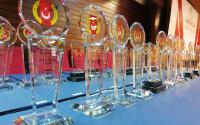6 June 2006Climate ArkNancy Beth Jackson
In 1979, two ecologists at Midwestern universities who knew each other only through their research came up with an audacious plan. They wanted exclusive rights to the top of Barro Colorado, a six-square-mile research island that had become one of the most studied spots on earth.
The island, a biological reserve in the Panama Canal, was administered by the Smithsonian Tropical Research Institute, so the two scientists, Robin Foster, then at the University of Chicago, and Stephen P. Hubbell, then at the University of Iowa, approached the institute's director, Ira Rubinoff, and proposed mapping and measuring every tree every five years to monitor population changes and to test conflicting theories about diversity in tropical forests. Their audacity lay in their asking to bar all other scientific inquiries from their plot, to prevent tiny seedlings from being squashed by scholarly boots. "I wasn't happy about that," Dr. Rubinoff recalled, but after hearing their argument, he agreed. They paced out a parcel of 50 hectares (about 124 acres), which the next year became the first in a global network of plots where scientists now track the fate of three million jungle trees. The network is run by the Center for Tropical Forest Science, created at the institute in 1990, and it coordinates 17 other plots — now called "earth observatories" — in Africa, Asia and Latin America, with more to come.In October the center headquarters moved from Washington to Panama, and a new director was appointed, Stuart J. Davies, an Australian ecologist, who had been science director of a joint program in Asia with the Arnold Arboretum at Harvard. Since Sept. 11, 2001, non-American scientists have found it easier to travel to meetings in Latin America or Asia than to the United States, Dr. Davies said.One of the greatest research benefits of the plots has been to allow scientists to measure, instead of guess, geographical ranges and population fluctuations in tropical forests. For example, Richard Condit, the center's scientific director, has monitored the effects of drought at the Barro Colorado site on two tree species since he arrived as a postdoctoral student in 1988. Dr. Condit has found that two species, common along the west coast of South America, declined "more rapidly than anyone imagined.""We know because we can show detailed information very precisely. With the 25-year scale in watching the forest, we know that forests and other nature systems change and can change pretty quickly."Data from the plots have provided the basis for a wealth of analysis. Working across borders and plots, scientists have been able to see a bigger picture of what is happening. A recent paper had 44 authors, reflecting the geographic reach of the research.Findings have also led to new theoretical models. Nature called Dr. Hubbell's book, "The Unified Neutral Theory of Biodiversity and Biogeography," published in 2001, "the bible of neutrality," a controversial theory suggesting that chance determines species survival rather than successful adaptation to an environmental niche. Before the Barro Colorado research began, most plots dedicated to tropical forest study were in Asia, measured less than a couple of acres and were devoted to improving lumber harvests rather than investigating the way species regenerate. Dr. Foster, now at the Field Museum of Natural History, and Dr. Hubbell, now at the University of Georgia, sought a larger area to account for tree migration as seeds hitchhiked on the breeze or animals and for the great diversity found in all tropical forests. Their open-air laboratory allowed them to study 300 species and some 300,000 trees from seedlings less than half an inch around to the giants of the forest canopy."Barro Colorado was the only place to do something like this," Dr. Hubbell said, pointing to decades of base-line research and terrain protected from incursions by poachers, farmers, lumberjacks and developers. Now, with the worldwide network of plots, Dr. Rubinoff said, "The program has come into its own and is already a global think tank. Everyone wants to go into the plots once they are mapped."At a recent workshop in Panama, researchers from the various plots gathered, each with a laptop, to crunch numbers collected in coordinated, long-term research. "A little United Nations in a room with the same data sets," Dr. Davies said.
Studies of such reach would have been impossible in the early days. "We didn't have the computing power. No way. On the first plot, we used I.B.M. punch cards on a mainframe. I don't want to go there again," said Dr. Hubbell, who is also senior staff scientist at the Smithsonian TropicalResearch Institute.
New technologies speed, simplify and expand the work at the plots. Census takers can find their way in the forest with global positioning devices and access and enter information on their personal digital assistants. Canopy towers, photos from airplanes and satellites, and DNA analysis are other tools now being tapped by plot researchers. At some camps, however, even basics are lacking. Scientists make do without electricity, wash their clothes in rivers and cook over open fires.Researchers still trek into the field to record the numbers. In the seedling census now under way on Barro Colorado, young biologists doing the tallies bound like ocelots up the steep path above Laboratory Cove through an idyllic forest where howler monkeys dangle and orchid bees hover. When the biologists reach the plot, they work alone, noses to the ground, rarely disturbed because the area remains off limits to most scientists and the small groups of tourists permitted to visit the island. Only an occasional slash of red paint, a tree tag or a metal rod hints at boundaries and subdivisions.The work is intensive, hard on the knees when surveying seedlings and requiring climbing when the circumference of a tree on buttress roots needs recording. But at the mother site, the biggest danger the researchers face is chigger bites. At other plots, stretched around the Equator like a belt, plot science takes on Indiana Jones dimensions. Deep in the forest, scientists can encounter tropical diseases, toxic ant bites, spitting cobras, smugglers and armed insurgents. More than one scientist from the forest center has had a close call.Corneille E. N. Ewango, monitoring the 100-acre Ituri Forest plot established in 1994 in Congo, received the Goldman Environmental Prize last year for hiding data on 600 species and 380,000 trees during a civil war. He himself hid in the forest for three months rather than desert his post."Though my country has the largest forest in Africa, it is one of the least known. We don't have so much research in botany in the Congo, except what we are doing," he explained when the prize was announced.Many of the world's lush rain forests and dry tropical forests remain uncharted even though more than half of all plants and animals live there in the greatest display of biodiversity on the planet. In the Amazon basin, perhaps the most diverse of all, a hectare of land (2.5 acres) can have 40 to 300 tree species compared with 4 to 25 in North American forests.The Center for Tropical Forest Science's sites, totaling 1,159 acres, monitor 6,000 species, or only about 10 percent of all known tropical tree species.Scientists estimate that tropical forests cover only 6 percent of the planet, less than half of what they once occupied. The Association for Tropical Biology and Conservation, founded to foster the exchange of ideas among scientists working in tropical environments, notes unprecedented changes, with 1.2 percent of the remaining area disappearing every year. The shrinking forests remain essential components in the global carbon and hydrological cycles. As elementary school children learn, trees act as a carbon reservoir, taking in carbon dioxide and releasing oxygen, although some studies suggest that the forests will not be able to absorb carbon from increased levels of carbon dioxide, a major greenhouse gas, and may even release more into the atmosphere. Mapping and measuring individual trees over time and across continents will help scientists have a clearer understanding of how global change will affect the forests and what to do about it. "We expect changes to accelerate," Dr. Hubbell said. "Data sets are absolutely irreplaceable at this point. We need more of them."Frank H. Levinson, who earned a doctorate in astronomy before founding Finisar, a fiber-optics communications company, agrees. "Are we a world in crisis? My gut says maybe, but my scientific head says get the data."He has pledged $10 million, hoping to leverage it fourfold through government and private financing, to expand the program and to give the tropical forest center "real long-term sustainability" through an endowment. "Biology is today where astronomy was 100 years ago. Today it is possible to collect very large data sets and for that data to be published and analyzed across the world by various people with various points of view. But without data there can be no honest debate," Dr. Levinson wrote in an e-mail message from Singapore, where he has set up a foundation called Small World Group.Dr. Levinson also volunteers as a self-described "nerd," sharing his engineering expertise with Smithsonian biologists. "I give money, but I also give time, because I am still a scientist myself. As a biological and ecological outsider, perhaps it is possible to offer some fresh perspective."He helped set up a wireless network to collect data in the Barro Colorado forest. "From that work we asked, What if we had a WiFi network as part of the infrastructure of every C.T.F.S. earth observatory? Would that help us collect better data? And so it goes."The Center for Tropical Forest Science is abuzz with such projects. Still unpacking at his office at the Smithsonian's Tupper Center in Panama, Dr. Davies has begun sketching out plans to expand the network with a short-term goal of monitoring at least 25 percent of the tropical land-based biodiversity, including unique environments like Madagascar. New plots would be the first additions in a decade. He wants to look backward through paleontological studies and forward by mapping DNA for each species in the plots."Some of the original questions are still there," said Dr. Rubinoff, of the Smithsonian Tropical Research Institute, as he appraised Barro Colorado data charts on which tree species were scattered like so much confetti. "We've fine-tuned a lot," he said, "but there are still lots of things we don't understand."






